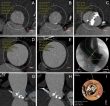Balloon Rupture during Pre-Dilation for Transcatheter Aortic Valve Replacement in Patients with Bicuspid Aortic Valve: Classification, Treatment Strategies, and Prevention
Abstract
Balloon rupture during transcatheter aortic valve replacement (TAVR) is a rare but serious complication. We present two cases of balloon rupture in patients with severe aortic stenosis and type 0 bicuspid aortic valve. Three-dimensional models based on pre-procedure cardiac CT angiography were used to post hoc investigate these cases. The models revealed asymmetrical distribution of calcifications with sharp spiked features in bicuspid aortic valves. The narrow and calcified orifice resulted in uneven force distribution on the expanded balloon, leading to balloon rupture. Furthermore, we reviewed the classification and causes of balloon rupture and summarized avoidance methods and treatment options. Accurate pre-procedural anatomy evaluation and computer modeling are crucial for planning and managing TAVR procedures. Further investigation through computer simulation is needed to determine the appropriate balloon size and inflation locations to provide the reference of preparation pre-procedure.


